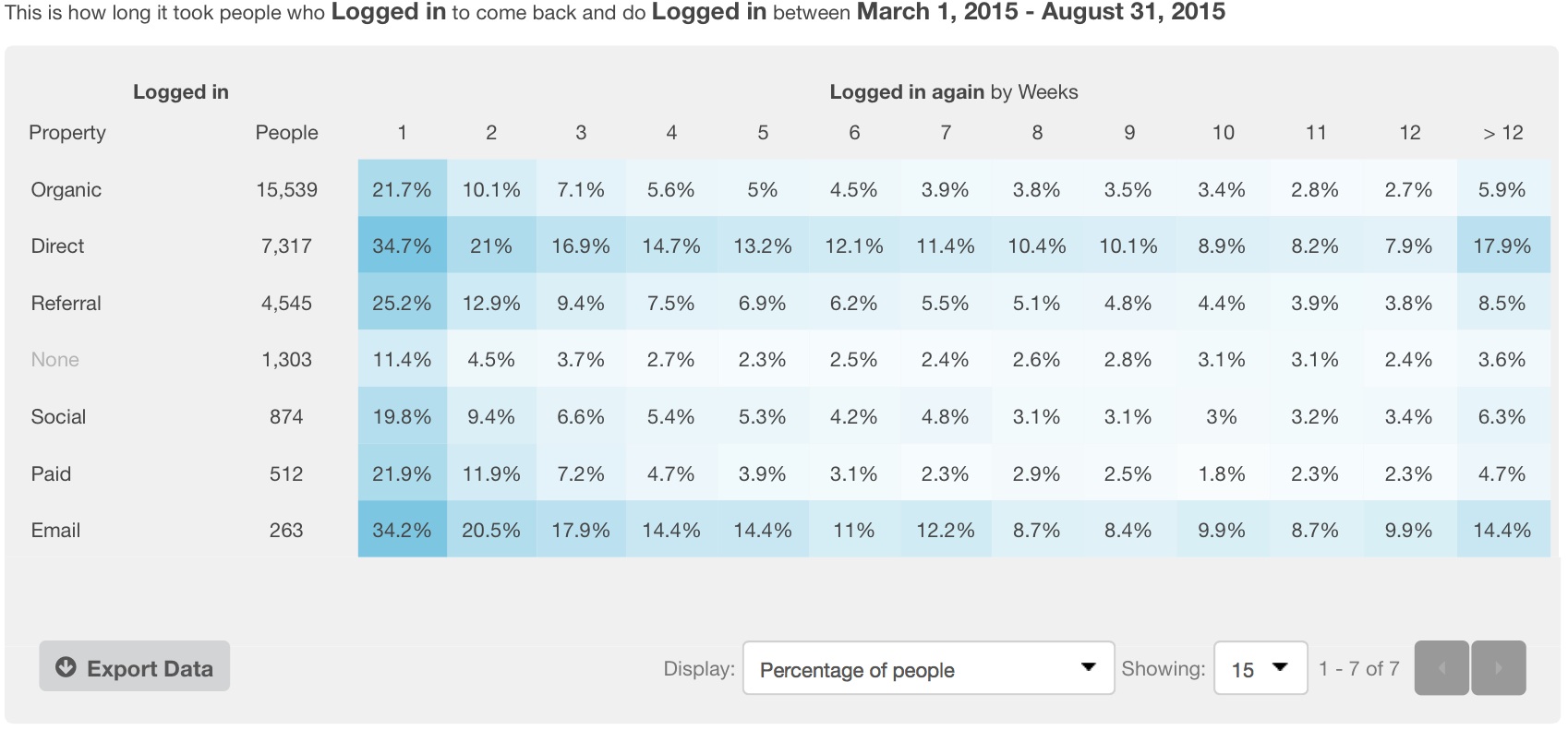What Marketers Need to Know About Cohorts
By Zach Bulygo
The word “cohort” can be scary to those unfamiliar with the term. It may sound like something out of a medical journal or statistics class. But, I promise you, there’s nothing to be afraid of. And, if you’re a marketer, it’s pretty important to understand cohorts if you want to get into and benefit from marketing analytics.
So, what is a cohort? Wikipedia defines it as:
“A cohort is a group of subjects who have shared a particular event together during a particular time span (e.g., people born in Europe between 1918 and 1939; survivors of an air crash; truck drivers who smoked between age 30 and 40).”
Pretty simple, right?
And, if you’re one those left-brained people who love to analyze data, then cohorts are perfect for you.
Cohorts are frequently used in studies to compare groups of people. They’re useful because, in a cohort study, you track the cohorts over a period of time to see what kind of data each one brings.
To use one of the examples from above, you could study truck drivers who smoked between age 30 and 40 compared with those who didn’t smoke at all and/or those who smoked earlier or later in life. You would then look at various test results for each cohort and compare the data.
Now, we’re not going to be talking about truck drivers who smoked. Since we’re marketers, we’re going to run through how we can apply cohorts to optimize our marketing. We’ll also examine a couple of tools that offer cohort analysis.
How Can Marketers Use Cohorts?
There are literally hundreds of cohorts marketers can create. But, the question here is not how many they can create. It’s which cohorts will produce the most insightful data.
When thinking about which cohorts to track, ask yourself these questions:
- Will the data I get from these cohorts produce insights that can change my marketing strategy?
- Will I be able to clearly know what’s working and what’s not when it comes to marketing?
- What targets do I need to hit this year? Will this cohort help me improve that metric?
Here are three cohorts marketers may find useful:
1. Signed Up / Purchased, Organized by Time
You’re a marketer, so it’s critical for you to deliver leads and signups to your sales team. Create a cohort that tracks people who visited your site and signed up. You’ll see when they first visited your site and how long it took them to sign up after their first visit. This can essentially tell you if your marketing campaigns lead people to take immediate action. Let’s break it down.
The new year begins, along with your new marketing campaign. You’ve spent the past 2 months planning it, designing it, and setting targets. Now it’s prime time, and you’re ready to see how it performs.
Your campaign runs from January – March. You get 100k visitors to your site, and your signup rate during this time remains at .5%. You start a new campaign in April.
Fast forward a few months, and you’re looking at a Cohort Report. You’re viewing the people who visited your site and signed up. For the people who visited your site sometime in the period January – March, you notice a slight increase in signups in the months following. You see that 1.0% of the people who visited your site in February came back in June and signed up. This means that the January – March campaign was more effective than initially thought.
As marketers, we often expect people to sign up right away. In our minds, we think they come to our site and either sign up or don’t. But the truth is, it’s not that binary. It’s not a yes or no at that very moment. Sometimes it’s a “wait and see.” People might visit our site, browse around, but then not sign up until later.
This is why it’s a useful cohort. Signups don’t always occur right away, and a cohort reporting tool can track signups over a long period of time.
2. Your Most Loyal Customers
Every marketer wants to acquire customers. But, as we know, not all customers are created equal. Some spend more than others, and some may require more “help” than others. There are also customers who sign up for your service and cancel a few months later (which doesn’t help your Cost to Acquire a Customer (CAC)). Most important, there are customers who sign up, stay engaged with your product, and tell their friends about it. You need to know who these customers are, where they came from, and how you can get more of them.
With a sophisticated Cohort Report, marketers can create a cohort of users who frequently login, and then they can segment (aka group) those users by the marketing channel they came from.
Here’s a way to think about it:
Your marketing challenge is finding loyal customers. You have no problem delivering signups, but 80% of them cancel their accounts after a few months. What about the other 20%? Where do they come from and how do you get more of them? This is where a Cohort Report can help you.
This is the Kissmetrics Cohort Report. It’s one of the best places to get this kind of data.
On the left, we see the marketing channel users came from. Move to the right, and you’ll see how well each channel performed. The darker the shade of blue, the higher the login retention.
With this information, we can see which channels are sending us the most valuable customers and then spend more money and energy on them and less on the ones that aren’t delivering.
3. Repurchase Rates
Every business needs loyal customers. That includes retail stores, SaaS companies, subscription-based companies, you name it. They need customers who come back and make purchases on a recurring basis. There’s no getting around it.
So how do you, as a marketer, find and acquire these loyal customers? Use a cohort. Here’s what you’ll want to do:
Find the people who have repurchased. This can be for any business, but let’s use e-commerce as an example. Then segment the purchases by product categories, marketing channels, or marketing campaigns. Here’s what you’ll learn:
- Do certain product categories keep people coming back? Maybe people who purchased ties come back frequently and purchase other items. If so, it’s time to start promoting your tie collection more often.
- Do any marketing channels have a tendency to bring loyal customers? For example, perhaps your AdWords campaigns are outperforming your Facebook ad campaign in bringing repeat purchases. If this is the case, you’ll want to spend more time and money on the AdWords campaigns.
- You have dozens of marketing campaigns running. You have seasonal campaigns running four times a year and dozens of other campaigns running in between. With a Cohort Report, you’ll find out which ones drive purchases and repurchases.
The Value of Cohorts for Marketers
As you can see, there are many insights you can gather by grouping people together and tracking their behavior over time.
Each business and marketing challenge is unique. I’ve listed a few ways marketers can use cohorts to help optimize their marketing. But your challenges are unique, and only you will be able to create cohorts that garner valuable insight.
Where to Get This Data
There are two tools we’ll focus on that provide cohort reporting. The first is Google Analytics and the other is Kissmetrics. Let’s start by examining Google Analytics.
Google Analytics Cohort Analysis
Google Analytics has a feature called Cohort Analysis. Here it is:
You have four choices in setting up your cohort analysis:
Cohort Type
This is where you choose a cohort. Acquisition Date, for example, groups people based on when they first came to your site.
Cohort Size
Here you choose the time frame for each cohort. You can measure people on a daily, weekly, or monthly basis.
Metric
Here you choose what you’ll be measuring for each cohort. There are a variety of choices.
Date Range
You have a variety of date ranges you can choose from. This is determined by the size of your cohort. For example, if you choose a cohort size “by day” you’ll have the date range options of 7, 14, 21, and 30 days.
Underneath these options, the Cohort Analysis presents the data visualization. Users can see how well the cohort is performing over time.
The bottom part contains the raw numbers and the retention afterward. The darker the shade of blue, the higher the percentage (i.e., better retention).
The Cohort Analysis is still in its early stages. Some of the more advanced things you’ll want to do may be a little more difficult to set up in Google Analytics. It is, of course, free and does not inherently come with support. You can get support through a partner.
Kissmetrics Cohort Report
This report is one of the most customizable out there. You can track any event and property across a custom date range. Using this report, you’ll be able to measure how your marketing campaigns are performing and refine them based on the data. The report’s usefulness can also extend beyond the marketing department. Here are a couple of other departments that could use it:
Product Team
- Track the features users keep coming back to. Which ones aren’t used as often? Why? Getting answers to these questions will help improve future product iterations and can help you find your product/market fit.
- Know which features are used first by new users. Are new users gravitating toward one feature over another? What was their experience with this feature?
- Understand the feature utilization that leads to payment. Is one cohort of users, who use a feature or area of your site more often during their free trial, more likely to pay for your product or cancel? Perhaps some features turn people off and they never return. Knowing this can make a huge difference.
Sales Team
- Know the product plan that has the best retention. Your sales team should not knowingly be pushing product plans that have been shown to have higher churn.
- Does viewing a certain element on a page lead to a signup? Maybe visitors who downloaded a white paper are more likely to sign up. If so, you can push people to download that white paper and even ask the marketing department to create more white papers.
- Find which product features are used by each customer segment. For example, let’s say your sales team is trying to land a big account from a well-known SaaS company. To sell the account, your sales team needs to show them the features your other SaaS customers use. Think about it. You don’t want to show them features that none of your SaaS customers are using. You want to show them the features that their peers are getting value from.
Here’s a video demo of the Cohort Report:
If the video embed is not showing up, you can click here to view the video on the Wistia page.
Recap
We’ve gone through a lot. Here are the takeaways:
- A cohort is a group of subjects who have shared a particular event together during a particular time span (e.g., people born in Europe between 1918 and 1939; survivors of an air crash; truck drivers who smoked between age 30 and 40). To put it another way, a cohort is a group of people who have a similar characteristic. Their behavior is then tracked over a period of time.
- These cohorts can help marketers understand how groups of people compare against each other. If you have two groups with different behaviors, notice which one delivers the best results. Then refine your marketing with what you learn.
- Sometimes signups don’t occur right away. A visitor may visit your site in January, bookmark it, and then return in June to sign up. The June marketing campaign may incorrectly be attributed with the signup even though it was actually the marketing campaign in January that brought the visitor. This is where the Cohort Report comes in handy.
- One cohort that marketers commonly use is people who have signed up. Marketers can see how each marketing channel or campaign performs at delivering signups.
- Many tools provide cohort data, but we focused on two of them – Google Analytics’s Cohort Analysis and Kissmetrics’s Cohort Report. Both have their upsides. If you’re looking to get more advanced analysis, definitely go with the Kissmetrics Cohort Report. The Cohort Analysis tool is still in its early stages.
- The Cohort Report can be used by more than marketers. Nearly all departments in your company will be able to get useful data out of this report.
See How Cohorts Can Impact Your Marketing
Want to learn how the Cohort Report can help you optimize your marketing? Request a personal demo today!
About the Author: Zach Bulygo (Twitter) is a Content Writer for Kissmetrics.





























No comments